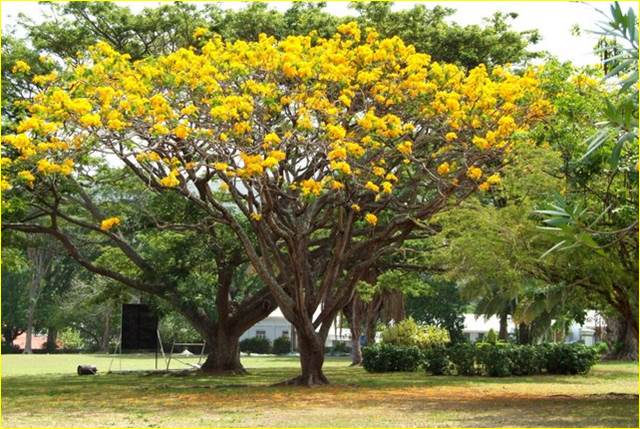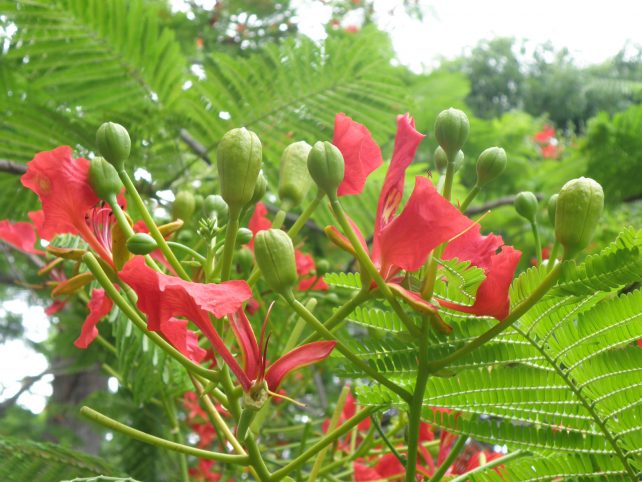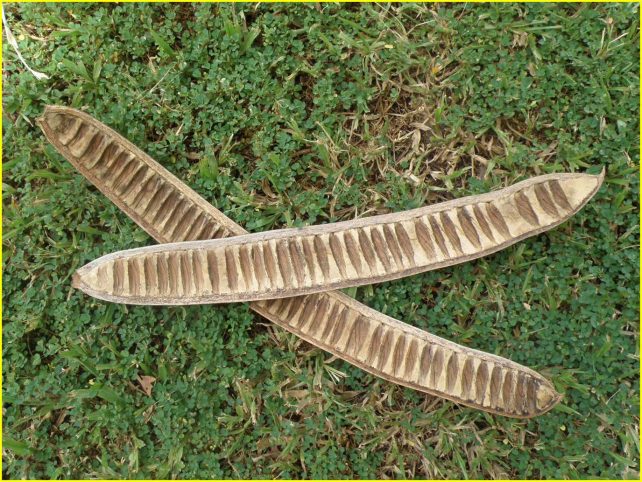
The previous section of the article presented on the Flamboyant tree and the Fishermen’s Feast, arts & crafts, botanical snacks and Mas Domnik, among other things. The article concludes below.
Children’s Games: Children love to play, and will utilize whatever they can find in their environment as sources of play materials and items. And so, four parts of the Flamboyant tree serve as children’s play items in coastal areas in Dominica.
Firstly, it was quite common for children to use the male parts of the Flambyant flower in the mature, unopened flower buds for playing. The game involves two children, each opening a flower bud then ‘arming’ himself/herself with one of the stamens and trying to unhook the anther (the ‘head’) from the filament of the stamen of his/her opponent. In some communities, the largest stamen in the flower bud was called “the king”, and its anther was often the most difficult to detach.

This game is probably the most popular use of the flower buds among Dominican children, and so it has been given several exotic names, such as ‘kòk-stikin’ (Roseau & environs), ‘kòks’ (Castle Bruce), ‘trili-kòk’ (Massacre, Salisbury), cock-and-pullet (e.g. Wesley, Portsmouth), cock-in-the-corner (Pointe Michel), cock-fight, fight, ‘bannta’ and possibly others.
In Petite Savanne the game is called ‘cock-screw’, and the children in that community even recognize a ‘queen’ and ‘king’ among the flower parts.
Interestingly, in the northern village of Capuchin that game is known as ‘ko-ki-yo-ko’, and the child who successfully removes the anther of his/her competitor’s Flamboyant stamen would imitate the crowing of a rooster, “Ko-ki-yo-kooooo”, teasing his/her opponent.
Méchansté: Another set of uses of parts of the Flamboyant tree by Dominican children is for engaging in mischief. Children in several communities around the island would resort to pelting each other with the smaller, immature flower buds of the Flamboyant tree, while in Soufriere, the young boys also pelted the dried seeds at one another.
Meanwhile, in some communities, young boys at school would rub dried seeds of this tree on a hard, rough surface until the seeds would become quite hot. They would then touch the skin of a classmate with the rubbed seed and this would cause a burning sensation on the skin. In Petite Savanne, children call the seeds of the Flamboyant tree ‘fwèt’.
Another mischief play utilizing another part of the Flamboyant tree could rightly be called, ‘take it like a child’. Children in the Wesley area used the stalk or mid-rib of the Flamboyant leaf as a whip or stinger to ‘discipline’ their ‘children’ while playing ‘mama’ games.
Down south in the village of Soufriere, school boys used to rub the dried Flamboyant seedpod on the edge of a desk until the seedpod got hot, and then touch the back of the neck of their classmate sitting in the row immediately in front of them with the hot seedpod.
Other Children’s Games: The Flamboyant seedpod is also used by Dominican children for playing other games. Two dried, unopened seedpods, would be shaken like a pair of maracas, which are called ‘chak-chak’ in Kwéyòl. This is possibly the most popular use of the seedpod on the island.
Children in Petite Savanne strike the two sections of the seedpod against each other to make a sort of clapping sound. Further, over in Colihaut children used a dried seedpod – or a section of the latter to represent a cutlass in their garden and mama games while, in some communities, those self-same seedpod sections represent swords in children’s mock fencing games.
The above games and play items involving the use of parts of the Flamboyant tree – and several other local plants – by Dominican children have been documented in “Playing With Plants in The Nature Isle”, which was produced by the author of this article and published by the Forestry, Wildlife & Parks Division in 2011.
The Tree’s International & Local Names: Internationally, the Flamboyant tree is known by several common names in various languages. However, its English common names include Fire tree, Flame of the Forests, Flame tree, Gold Mohar, Peacock Flower, Poinciana, Read tree, Royal Gulmohur, Royal Peacock, and Royal Poinciana.
Children in The Nature Isle sometimes assign their own names to some of the trees in their communities, based on their connection with the particular species, and the Flamboyant tree is no exception. For instance, in the Roseau area children call the Flamboyant tree Kòkstikin tree (after the game), Chak-chak tree and Donmbwè-san-sèl tree (after the snack), while their counterparts in Castle Bruce know the tree as the Kòks tree (after the game).

Your Personal Flamboyant Connection: Finally, as a Dominican you may have had some connection with the Flamboyant tree recently or in the past. Have you played Cock & Pullet (or however that game is called in your community) with the stamens of the flower buds? Or engaged in mock fencing games, or ‘clap-clap’, or shaken your ‘chak-chak’ using the dried seedpods? Or eaten ‘donmbwé-san-sel’ from the immature seeds? Or engaged in mischief-making using the flower buds, seeds, or dried seedpods? NO?
Then, maybe you used a Flamboyant ‘cutlass’ from a seedpod, or made a pair of beautiful earrings from the dried seeds, or climbed a Flamboyant tree, or simply enjoyed the shade of one of those magnificent trees. Or maybe you decorated your fishing canoe with Flamboyant flowers for Fèt La Sen Pyè, or you may have been reminded that we were in the season of that feast, or you simply admired the colourful, floristic explosion put on by Delonix regia – the Royal Peacock or Flamboyant tree.


Thank you Mr. James. Keep them coming.
Arl, we also use to scratch the seed of the ‘shake shak’ and when it gets hot, we rest it on our friends to burn them


Very interesting story on a very attractive plant Thanks Arlington